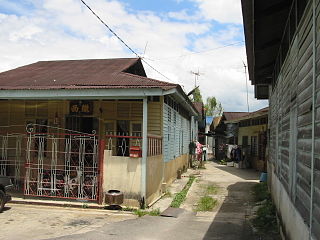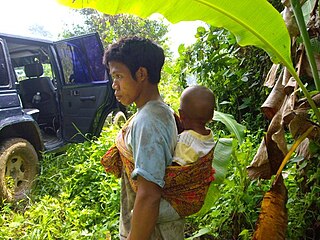
Orang Asli are a heterogeneous indigenous population forming a national minority in Malaysia. They are the oldest inhabitants of Peninsular Malaysia.

The National Museum is in Jalan Damansara, in Kuala Lumpur, Malaysia. The museum is close to Perdana Lake Gardens and it provides an overview of Malaysian history and culture. Its façade comprises elements from both traditional Malay and modern features. It was inaugurated on 31 August 1963, and it serves as a repository of Malaysia's cultural and historical heritage.

The Batek people are an indigenous Orang Asli people ; belonging to the Semang group, who live in the rainforest of peninsular Malaysia. As a result of encroachment, they now primarily inhabit the Taman Negara National Park. The Batek are nomadic hunters and gatherers, so the exact location of their settlements change within the general confines of the area that they inhabit.

Sultan Alam Shah Museum is a museum in Shah Alam, Petaling, Selangor, Malaysia. It is the state museum of Selangor. This museum was opened in 1989 by Sultan Salahuddin Abdul Aziz Shah.

Slim is a mukim in Muallim District, Perak, Malaysia. Variant names are Selim, Slim Village, Kampong Slim, and Slin..

New villages, also known as Chinese new villages, were internment camps created during the waning days of British rule in Malaysia. These camps were originally created as part of the Briggs Plan, first implemented in 1950 to isolate guerillas from their supporters within the rural civilian populations during the Malayan Emergency. Most were surrounded by barbed wire and watchtowers to stop people from escaping, with guards being ordered to kill anyone who attempted to leave outside of curfew hours.
The Duano' people, also called Desin Dolak or Desin Duano' are an indigenous people of Malaysia and Indonesia and can be found in islands along the northeastern region of Sumatra, Indonesia where most Duano' people have traditionally lived. They are one of the Proto-Malay group of cultures. Due to their nomadic boat lifestyle, based almost exclusively on fishing and collecting shellfish and crustaceans by using mud-boards, Duano' people are often categorized as Orang Laut, a group that includes the Urak Lawoi’ people and Moken people of the northern region of the Malacca Strait and the Andaman Sea. Although there are similarities in their way of life, they are a separate ethnic group. Citing their own language, culture, identity, and economic complexities, they deny being Orang Laut.

The Temuan people are a Proto-Malay ethnic group indigenous to western parts of Peninsular Malaysia. They can be found in the states of Selangor, Pahang, Johor, Negeri Sembilan and Malacca. The Temuans are classified as part of Orang Asli group according to the Malaysian government. They are also one of the largest and the most widespread of the Orang Asli ethnic groups.

The Senoi are a group of Malaysian peoples classified among the Orang Asli, the indigenous peoples of Peninsular Malaysia. They are the most numerous of the Orang Asli and widely distributed across the peninsula. The Senois speak various branches of Aslian languages, which in turn form a branch of Austroasiatic languages. Many of them are also bilingual in the national language, the Malaysian language.

The Temiar are a Senoic group indigenous to the Malay Peninsula and one of the largest of the eighteen Orang Asli groups of Malaysia. They reside mainly in Perak, Pahang and Kelantan. Their total population is estimated at around 40,000 to 120,000, most of which live on the fringes of the rainforest, while a small number have been urbanised.
Orang Kanaq are one of the 18 Orang Asli ethnic groups in Malaysia. They are classified under the Proto-Malay people group, which forms the three major people group of the Orang Asli. The Orang Kanaq are considered as the smallest Orang Asli group with the population of approximately 90 people only.
The Department of Orang Asli Development, abbreviated JAKOA, is the Malaysian government agency entrusted to oversee the affairs of the Orang Asli. This body is under the Malaysian Ministry of Rural and Regional Development and was first set up in 1954.

The Ministry of Rural and Regional Development is a ministry of the Government of Malaysia that is responsible for rural development, regional development, community development, Bumiputera, Orang Asli, rubber industry smallholders, land consolidation, land rehabilitation.

Orang Seletar are one of the 18 Orang Asli ethnic groups in Malaysia. They are classified under the Proto-Malay people group, which forms the three major people group of the Orang Asli. The Orang Seletar are also considered as part of the Orang Laut, natives of the Straits of Johor; separating Singapore from Peninsula Malaysia.

The Aborigines Museum is a museum in Ayer Keroh, Malacca, Malaysia, which showcases the native people relics found in the country. It was originally located inside Ayer Keroh Recreational Forest, but later relocated to its present area along Lebuh Ayer Keroh in December 1996 and went under the management of Malacca Museum Corporation. The museum was reopened on 3 February 1997.
Temoq people belong to the Proto-Malay of the Orang Asli ethnic group that are found in Pahang, Malaysia.
Semaq Beri or Semoq Beri people are the native Orang Asli people belonging to the Senoi branch, who live in the states of Pahang and Terengganu in peninsular Malaysia. The Semaq Beri language is a language spoken by the people, is an Austroasiatic language that belongs to the Southern grouping of the branch of Aslian languages.

Cheq Wong people are an indigenous Orang Asli people of the Senoi branch in Peninsular Malaysia. Although they have the physical appearance of the Senoi sub-group, the Cheq Wong language that they speak is closely related to the Northern Aslian languages.
Ajis bin Sitin is a Malaysian civil servant who has served as the Director-General of Department of Orang Asli Development from 2017 to 2019. He was appointed as a Senator on 25 August 2021 to represent Pahang.














